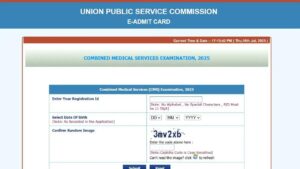Table of Contents
Pradhan Mantri Krishi Sinchai Yojana
The Pradhan Mantri Krishi Sinchai Yojana (PMKSY), a federally funded programme, was introduced in 2015 with the intention of increasing physical access to water on farms, increasing the amount of land that can be planted with guaranteed irrigation, increasing the effectiveness of on-farm water use, introducing sustainable water conservation practises, and other objectives. The Ministry of Jal Shakti is implementing the Accelerated Irrigation Benefit Programme (AIBP) and Har Khet Ko Pani (HKKP), which together make up the PMKSY umbrella programme. This post will go through the Pradhan Mantri Krishi Sinchai Yojana (PMKSY), which is beneficial for preparing for the UPSC exam.
Pradhan Mantri Krishi Sinchayee Yojana (PMKSY) Introduction
By offering a complete solution for source creation, distribution, management, field application, and extension activities, the Pradhan Mantri Krishi Sinchayee Yojana (PMKSY) aims to increase irrigation coverage (‘Har Khet ko pani’) and water use efficiency (‘More crop per drop’) in a targeted manner. It is being used to enhance the amount of land that can be grown with reliable irrigation, decrease water waste, and boost water usage effectiveness.
Through the use of “Jal Sanchay” and “Jal Sinchan,” PMKSY works on both establishing reliable irrigation sources and establishing protective irrigation. Additionally subsidised is micro irrigation in order to guarantee “per drop-more crop.” The Pradhan Mantri Krishi Sinchayee Yojana (PMKSY) was authorised during the Cabinet Committee on Economic Affairs’ meeting on July 1st, 2015, which was presided over by the Honourable Prime Minister.
An Inter-Ministerial National Steering Committee (NSC), headed by the Prime Minister and made up of Union Ministers from pertinent Ministries, would oversee and keep tabs on PMKSY. Under the direction of the Vice Chairman of NITI Aayog, a National Executive Committee (NEC) would be established to manage the execution of programmes, resource allocation, inter-ministerial coordination, monitoring, and performance evaluation, as well as the resolution of administrative difficulties.
The Integrated Watershed Management Programme (IWMP) of the Department of Land Resources (DoLR), the On Farm Water Management (OFWM) of the Department of Agriculture and Cooperation (DAC), and the Accelerated Irrigation Benefit Programme (AIBP) of the Ministry of Water Resources, River Development, and Ganga Rejuvenation were combined to create PMKSY.
With a budget of Rs. 50,000 crore over five years, PMKSY has been given the go-ahead for nationwide implementation. All states and union territories are included in the programme, including those in the North Eastern region.
Pradhan Mantri Krishi Sinchayee Yojana (PMKSY) Objective
Converge irrigation investments at the field level (district and, if necessary, sub-district water use plans drafting). It Enhance physical access to water on the farm and increase the amount of arable area with reliable irrigation. It aids in integrating water supply, distribution, and effective usage to maximise water consumption through the use of suitable technology and procedures.
It aids in enhancing the effectiveness of on-farm water use in order to decrease waste and enhance availability in terms of both duration and extent. Expand the use of water-saving technologies like precision irrigation. Increase aquifer recharging and put long-term water-saving practises into place. By utilising the watershed approach to soil and water conservation, groundwater regeneration, runoff control, and other NRM operations, ensures the integrated development of rainfed areas.
Encourage farmers and field workers to take part in extension activities for crop alignment, water management, and harvesting. Analyse the potential for peri-urban agriculture utilising treated municipal wastewater. Encourage more private irrigation investment.
Pradhan Mantri Krishi Sinchayee Yojana (PMKSY) Implementation
In order to enable States to develop a District Irrigation Plan (DIP) and a State Irrigation Plan (SIP), PMKSY seeks to establish a “decentralised State level planning and execution” framework. DIP will have a comprehensive view of the district’s growth, detailing medium- to long-term plans that integrate three elements: water sources, a distribution network, and district water usage applications that will be created at two different levels: the block and the district. All structures built under the programmes will be geotagged. All DIPs are combined into the State Irrigation Plan, which also manages the agricultural plans created by the Rashtriya Krishi Vikas Yojana.
Pradhan Mantri Krishi Sinchai Yojana (PMKSY) Components
Accelerated Irrigation Benefit Program (AIBP)
- To focus on faster completion of continuous Major and Medium Irrigation, including National Projects.
Har Khet Ko Pani (HKKP)
- Minor irrigation is utilised to produce new groundwater and surface water sources.
- Renovation, repair, and maintenance of waterbodies.
- Expanding the carrying capacity of conventional water sources and building rainwater collection systems (Jal Sanchay).
- The establishment of a distribution network from the source to the farm, as well as the development of the command area.
- Groundwater development in places with adequate supplies so that a washbasin can be built to collect runoff and floodwater during the wettest part of the year.
- Improving water distribution and management systems for water bodies to make the most of resources that are now underutilised and to reap the rewards of low-hanging fruit.
- Rerouting water from sources in places with ample water supplies to others with a lack of water nearby.
- Establishing and reviving conventional water storage systems in sites that are practical, such as Jal Mandir (Gujarat), Khatri, Kuhl (HP), Zabo (Nagaland), Eri, Ooranis (TN), Dongs (Assam), Katas, Bandhas (Odisha and MP), and others.
- HKKP is made up of four sub-components:
- Command Area Development & Water Management (CAD & WM)
- Surface Minor Irrigation (SMI)
- Repair, Renovation, and Restoration (RRR) of Water Bodies
- Groundwater (GW) Development.
Per Drop More Crop (PDMC)
- Programme management, State/District Irrigation Plan creation, annual action plan approval, monitoring, and so on.
- In the agricultural setting, promoting the use of drippers, sprinklers, pivots, and rain-guns as precise water application tools.
- Exceeding the legal limit (40%), in particular for civil construction, on input costs for tasks such lining inlets, outlets, distribution systems, silt traps, and so forth.
- Building micro irrigation structures in accordance with block/district irrigation plans to support source creation initiatives, such as digging wells and tube wells that are not funded by AIBP, PMKSY (Har Khet ko Pani), PMKSY (Watershed), or MGNREGS.
- Secondary storage structures at the end of the canal system to store water when it is plentiful (rainy season) or from enduring sources like streams for use during dry periods through efficient on-farm water management.
- Water lifting apparatus such as diesel/electric/solar pumpsets, water conveyance pipes, and underground piping systems.
- Extension initiatives that support scientific moisture conservation and agronomic practises such crop alignment to maximise the use of available water, including rainfall, and lessen the need for irrigation;
- Only after completing the required training will extension workers be permitted to distribute pertinent technology under PMKSY.
- ICT interventions through NeGP-A to be employed in the fields of water usage efficiency, precision irrigation technology, on-farm water management, crop alignment, etc., as well as rigorous monitoring of the Scheme.
Watershed Development (WD)
- Watershed-wide improvements to soil and moisture conservation practises, such as the treatment of drainage lines, ridge area treatment, rainwater collecting, in-situ moisture conservation, and other related activities.
- Working along with MGNREGS to create backward rainfed blocks’ full potential for water sources, including traditional water body refurbishment.
Pradhan Mantri Krishi Sinchai Yojana (PMKSY) Limitations
Only 10% of the projects started under the PMKSY watershed development component have been finished, per a 2018 report by the Parliamentary Standing Committee on Rural Development. Process constraints caused by bureaucracy obstruct it. Corruption is yet another serious issue. delay in the execution of the project.
When it comes to missing goals, accountability is not mentioned. Small landowners cannot afford the higher expenditure required to implement “Per Drop More Crop,” which calls for the use of pricey sprinklers and drip irrigation. The PMKSY does not disclose the degree of government support for farmer investments in micro-irrigation or incentives for farmers to use such micro-irrigation.
There are not enough experts. There are so many generalists in PMKSY, especially bureaucrats. being unable to purchase land before funding. This has a detrimental effect on the project and prevents it from achieving its goals. Prioritisation is being impacted by large obligations under AIPW and IWMP. Free power and water are major obstacles to the use of precision irrigation. Departments don’t work together or coordinate well enough.
Pradhan Mantri Krishi Sinchai Yojana (PMKSY) Ministries Involved
Ministry of Agriculture
Encourage the construction of micro-irrigation structures to supplement source creation activities, extension activities for the promotion of scientific moisture conservation, and agronomic measures. Promote efficient water conveyance and precision water application devices like drips, sprinklers, pivots, and rain-guns in the farm “(Jal Sinchan)”.
MoWR RD & GR
Take several steps to provide a reliable irrigation source, including building canals, field channels, water diversion/lift irrigation, and water distribution systems.
Ministry of Rural Development
Take several steps to provide a reliable irrigation source, including building canals, field channels, water diversion/lift irrigation, and water distribution systems.
Pradhan Mantri Krishi Sinchai Yojana (PMKSY) Committee Involved
National Steering Committee (NSC): There are Union Ministers from all relevant Ministries on this Inter-Ministerial Committee, which is headed by the Prime Minister. It will oversee and keep track of the programme at the federal level.
National Executive Committee (NEC): Should be established with the Vice-Chairman of NITI Aayog as its chairman. It will be in charge of overseeing programme execution, interministerial coordination, resource allocation, performance monitoring, and performance assessment, among other things.
State Level Sanctioning Committee (SLSC): To oversee the administration of the programme at the state level, SLSC will be presided over by the Chief Secretary of the relevant States. It will be fully empowered to approve the project and oversee the implementation of the plan.
District Level Implementation Committee: Ensure field level coordination at the district level to ensure the last mile
Pradhan Mantri Krishi Sinchai Yojana (PMKSY) UPSC
The Indian government is devoted to giving water management and conservation high priority. At the field level, PMKSY seeks to achieve convergence of irrigation investment. The Pradhan Mantri Krishi Sinchayee Yojana (PMKSY)’s primary goal is to give all agricultural fields in the nation access to some type of protective irrigation so they may produce “per drop more crop” and bring about much-needed rural prosperity.


 UPSC CMS Admit Card 2025 Out: Download L...
UPSC CMS Admit Card 2025 Out: Download L...
 UPSC Study Material for Prelims & Ma...
UPSC Study Material for Prelims & Ma...
 Mukhyamantri Majhi Ladki Bahin Yojana, O...
Mukhyamantri Majhi Ladki Bahin Yojana, O...





















